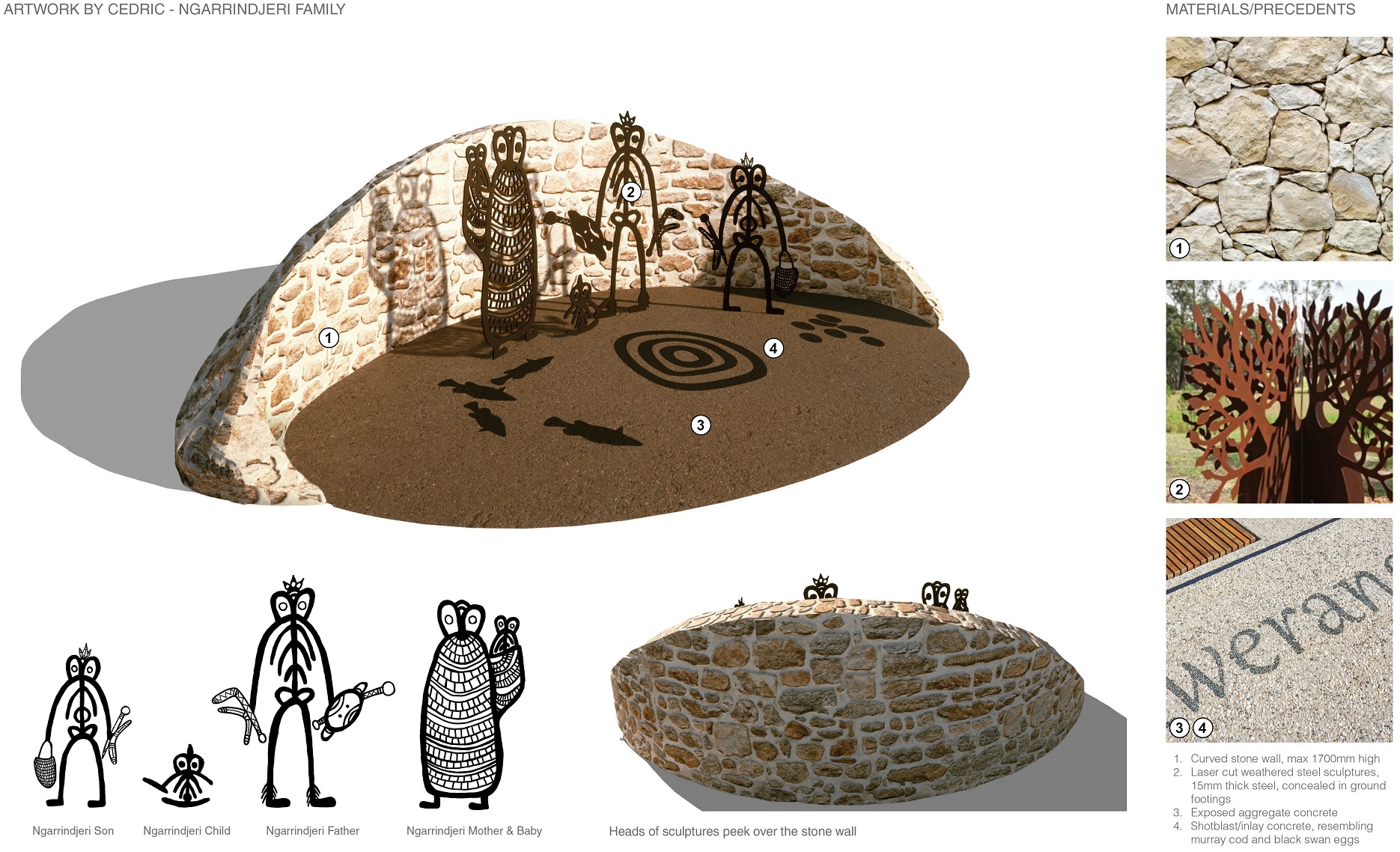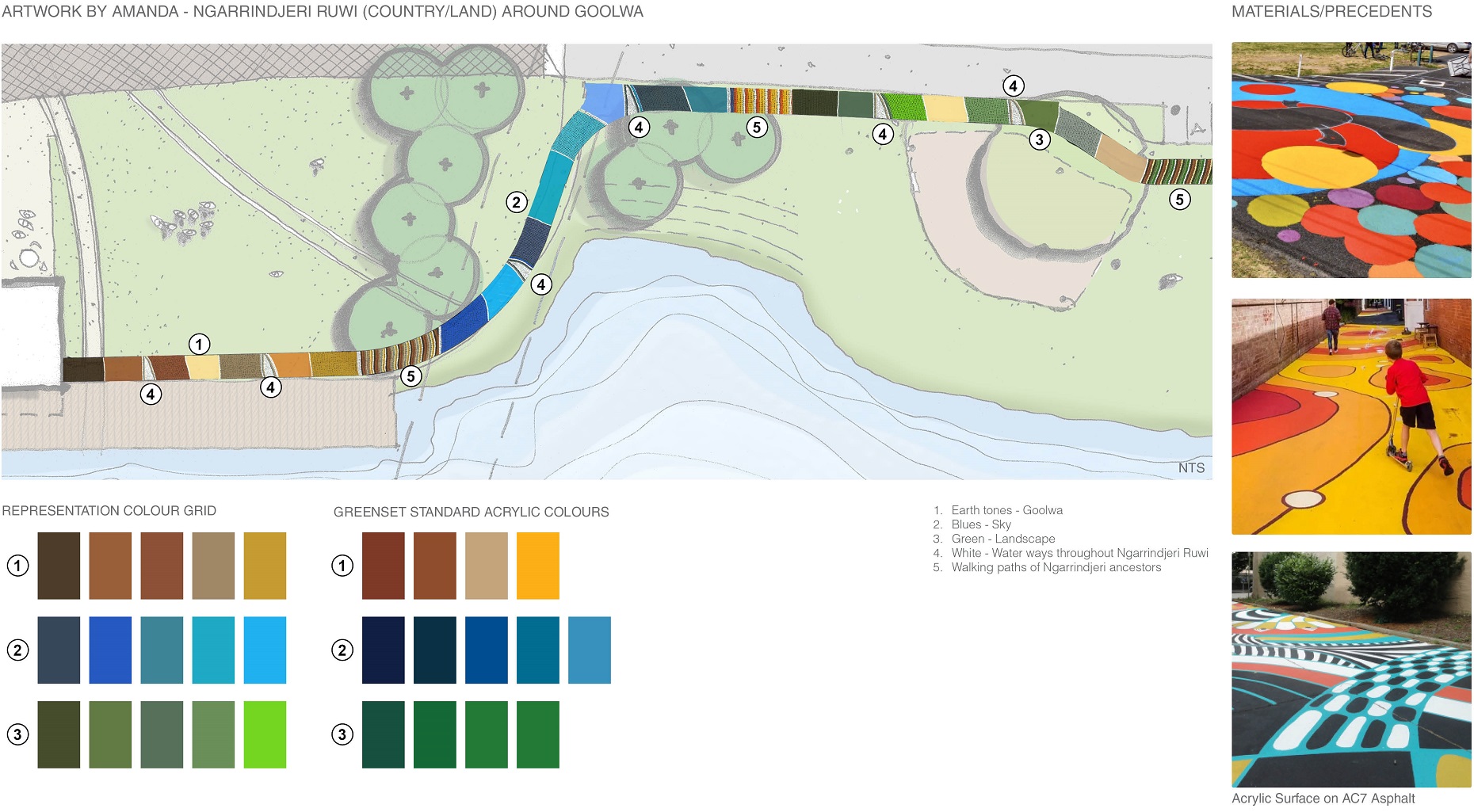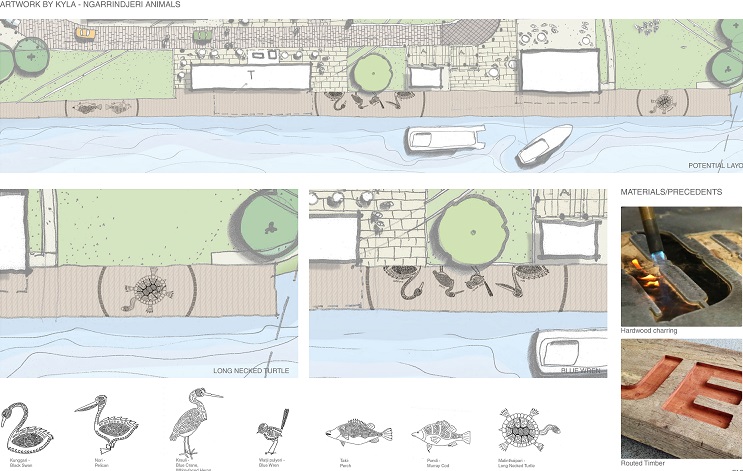The Goolwa Wharf Precinct location holds great cultural significance to the Traditional Owners, the Ngarrindjeri People. The Project Team together with Ngarrindjeri Aboriginal Corporation (NAC) established a ‘collaborative co-design team’ who have worked together to derive concept designs for the inclusion of Ngarrindjeri artwork as part of the Goolwa Wharf Precinct Project.
The proposed artworks reflect concepts of family, Country, knowledge and culture and the special connection Ngarrindjeri have to their Ngartjis and their totems. These artworks speak of Ngarrindjeri culture and express the principles of 'moving forward together’. The concept artwork designs are provided below.
A series of metal sculptural figures express the importance of family. The artwork is centred on an abstraction of a campsite. Concepts of congregation, custom, fire, shelter, and food are expressed in the symbols and arrangement of the artwork. The piece invites a conversation about what family means and the significance of culture and custom for Ngarrindjeri. This concept artwork is now a public art sculpture located at nearby Goolwa Beach.

Using the footpath to Amelia Park as a canvass to retell the story of the Ngarrindjeri Country. The painted colours and detailed patterning of her work conceptualises the landscape of Goolwa and the Coorong. The different colours painted on the footpath represent the earth, sky, water and landscapes throughout Ngarrindjeri Ruwi. Details in the painting reflect on the walking paths of Ngarrindjeri ancestors.

Telling the story of the Ngarrindjeri Ngartjis. The deep and unbroken connection that the Ngarrindjeri have with the land, water, animals and plants. The Ngartjis are special friends that support, protect and guide the Ngarrindjeri. Kyla's work is located on the wharf, close to the nourishing waters of the Murray and the Coorong. Each Ngartji is charred into the wharf, a permanent mark that honours the importance of each Ngartji.

Public Art - Helpmann Academy
In late 2020, a family with generations of history and very fond memories of holidaying in Goolwa wished to donate a public artwork to be located in Goolwa. They wished the artwork to be reflective of the quality family time that they and many families had experienced in the township. The donors collaborated with the Helpmann Academy in bringing the project to Alexandrina Council. The Helpmann Academy is the only organisation of its kind in Australia offering opportunities to emerging creatives unifying the skills and resources of the state’s universities since 1994. The artists qualifying for this career defining commission would need to be a graduate from one of the partner institutions of the Helpmann Academy. Over the period from June to December 2021, a select group of artists were required to develop their artwork concepts, present to the judging panel and provide details around the rationale and representation of ‘family’.
‘Alluvial Hearthstone / nukan kungun (looking and listening) ’was declared the winning artwork of the Helpmann Academy Major Public Art Commission for the Goolwa Wharf Precinct. See the link following to read the full joint Media release - 18 February 2022.
Hearthstone is a sculptural work imbued with a sense of discovery and curiosity; a place that is revisited, spent time in/with; a place that unfolds as the relationship with this site develops. Hearthstone is proposed to be positioned across three sites within the overall Goolwa Wharf Precinct project to create a thematic integration across the precinct. Linking places throughout the precinct area, these multiple points of reference create a sense of story with repeated sculptural and landscape motifs. This approach is inspired by Goolwa as a location itself: as a node along the river artery, a connective point for families, wildlife, industry and memories through history.
There are three main elements to Hearthstone; Family Gatherings Nodes (etched granite stones), Reed like forms (steel and bronze), Alluvial Stones (granite boulders). These sculptural motifs are a node to the natural lightness and buoyancy of the place, a sense of water flow and with an appreciation of the effects of changing seasons that are present on the Goolwa Waterfront (sun, cloud cover, wind, and wet weather). The node stones are engraved with drawings and stories of place from the first people of Goolwa, collected and presented through working collaboratively with Ngarrindjeri, including Jekeyere, Kuti the cockles, Nori the pelican and The Seven Sisters.
